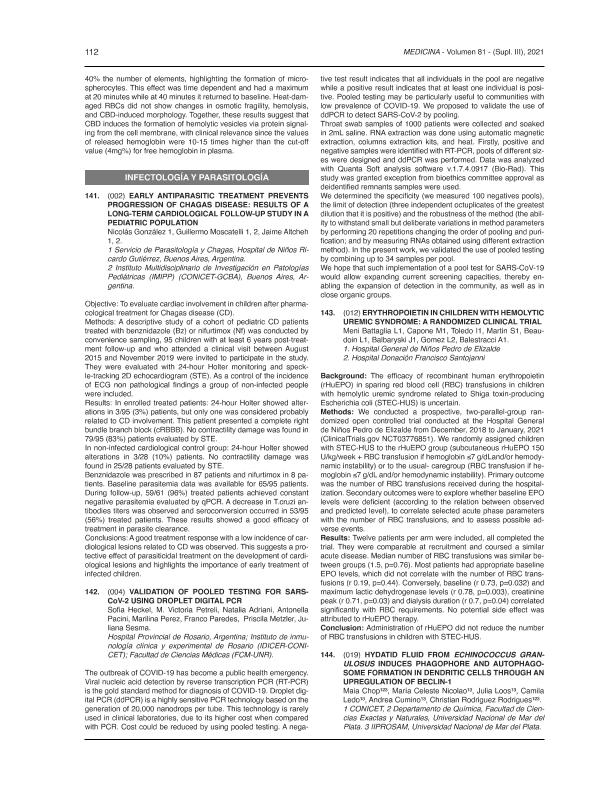Evento
Hydatid fluid from Echinococcus granulosus induces phagophore and autophagosome formation in dendritic cells through an upregulation of Beclin-1
Chop, Maia ; Nicolao, María Celeste
; Nicolao, María Celeste ; Loos, Julia Alexandra
; Loos, Julia Alexandra ; Ledo, Camila
; Ledo, Camila ; Cumino, Andrea Carina
; Cumino, Andrea Carina ; Rodríguez Rodrígues, Christian Fernando Ariel
; Rodríguez Rodrígues, Christian Fernando Ariel
 ; Nicolao, María Celeste
; Nicolao, María Celeste ; Loos, Julia Alexandra
; Loos, Julia Alexandra ; Ledo, Camila
; Ledo, Camila ; Cumino, Andrea Carina
; Cumino, Andrea Carina ; Rodríguez Rodrígues, Christian Fernando Ariel
; Rodríguez Rodrígues, Christian Fernando Ariel
Tipo del evento:
Reunión
Nombre del evento:
LXVI Reunión Anual de la Sociedad Argentina de Investigación Clínica; LXIX Reunión Anual de la Sociedad Argentina de Inmunología; LIII Reunión Anual de la Asociación de Farmacología Experimental y XI Reunión Anual de la Asociación Argentina de Nanomedicinas
Fecha del evento:
17/11/2021
Institución Organizadora:
Sociedad Argentina de Investigación Clínica;
Sociedad Argentina de Inmunología;
Asociación de Farmacología Experimental;
Asociación Argentina de Nanomedicinas;
Título de la revista:
Medicina (Buenos Aires)
Editorial:
Fundación Revista Medicina
ISSN:
1669-9106
Idioma:
Inglés
Clasificación temática:
Resumen
Background: The cestode Echinococcus granulosus (Eg) is the etiological agent of cystic echinococcosis. This parasite develops cysts filled with hydatid fluid (HF) in the viscera of the intermediate host. Autophagy is a cellular catabolic process that plays a key role in the presentation of endogenous and exogenous proteins, promoting the activation of T cells. The aim of this work is to analyze if HF, constituted by a wide range of parasite proteins, could trigger autophagy in dendritic cells. Methods: HF was punctured from the hydatid cysts collected of infected cattle slaughtered. Murine BMDCs were cultured in RPMI 1640 medium, supplemented with FLT3-L. First, lysosome activity was evaluated using Acridine Orange, a fluorophore that can be trapped in acidic vesicular organelles. Then, autophagy induction was evaluated by FACS, qPCR, Confocal and Transmission Electron Microscopy. Rapamycin (20 nM) and chloroquine (100μM) were used to modulate autophagic flux. LC3-attachment to the autophagic membrane, were analyzed by stained DCs with anti LC3-β antibody (clone H50). Results: HF significantly increased acridine orange cytoplasmic accumulation compared to control cells (***p <0.001) and enhanced the effect of rapamycin (****p<0.0001). The ultrastructural analysis of TEM showed that in the presence of HF, DCs stimulate the formation of phagophores, double lipid membrane autophagosome, MVBs and autolysosomes. Also, HF-stimulated BMDCs significantly enhanced the mean fluorescence intensity of LC3-positive structures in comparison with unstimulated cells (*p<0.05, **p<0.01, ***p<0.001 HF-stimulated cells vs controls). Finally, we have observed that HF induces a significant increase in the transcriptional expression of LC3 and Beclin-1 (n=3, **p <0.01 vs control) and enhances the expression induced by rapamycin. Conclusions: These results suggest that HF of Echinococcus granulosus regulates gene expression to increase autophagy- related structures in DCs.
Palabras clave:
ECHINOCOCCUS
,
AUTOPHAGY
,
DENDRITIC CELLS
,
BECLIN-1
Archivos asociados
Licencia
Identificadores
Colecciones
Eventos (IIPROSAM)
Eventos de INSTITUTO DE INVESTIGACIONES EN PRODUCCION, SANIDAD Y AMBIENTE
Eventos de INSTITUTO DE INVESTIGACIONES EN PRODUCCION, SANIDAD Y AMBIENTE
Citación
Hydatid fluid from Echinococcus granulosus induces phagophore and autophagosome formation in dendritic cells through an upregulation of Beclin-1; LXVI Reunión Anual de la Sociedad Argentina de Investigación Clínica; LXIX Reunión Anual de la Sociedad Argentina de Inmunología; LIII Reunión Anual de la Asociación de Farmacología Experimental y XI Reunión Anual de la Asociación Argentina de Nanomedicinas; Argentina; 2021; 112-113
Compartir



